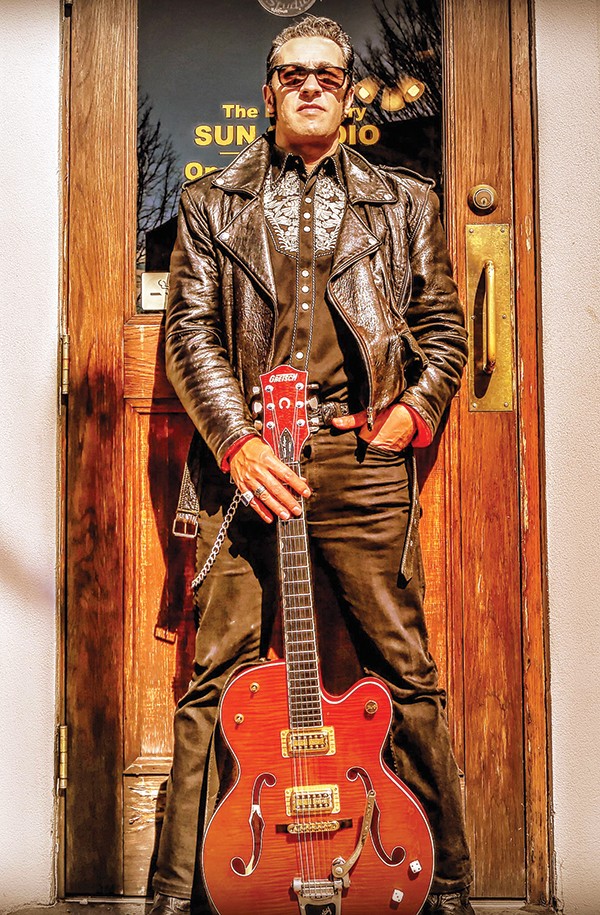With foreigners and asylum-seekers now becoming the objects of some folks’ daily two-minute hate, it’s worth noting the value of immigrants in the Memphis music scene. Guitarist Mario Monterosso has been in Memphis more than two years, but he’s not the first Italian to seek a fortune in the Bluff City. W.C. Handy wrote of another, “a ragged immigrant boy, a dark-browed Italian youngster called Pee Wee, [who] crept out from under one of the box cars. He had come all the way from New York on the rods.” Later, the youngster came into his own on Beale Street. As Handy recalled, “When I first visited the city as a boy, Pee Wee was running a saloon … and his place became almost a landmark and a legend. Moreover, it was a headquarters for musicians.”
Unlike Pee Wee, Monterosso came to Memphis wielding a guitar, but like Pee Wee, he found a home on Beale. Many have marveled at this newcomer’s playing with the likes of Dale Watson or John Paul Keith and wondered what his story could be. It’s a tale of the fascination a boy had with the music of the American South.
Hailing from the ancient port of Catania, on Sicily’s eastern shore, Monterosso recalls that “music was part of my family. My great aunt was a very important opera singer in Italy. And my sister was a classical pianist. My father used to write about the opera.”
 Photographs by Billy Morris
Photographs by Billy Morris
Mario Monterosso, an Italian guitarist in Memphis
But for the young Monterosso, the muses of the Old World were no match for those of the New. “When I was 10, my sister had a rockabilly boyfriend. My father died in the same period, so this guy became a kind of role model. And the first time I went with them to a concert, I saw this guy named Vince Mannino. With this big quiff and sideburns, and a rockabilly drape. A real Teddy Boy. He was singing ‘Boogie Woogie Country Girl,’ and I said ‘Wow, what is this? I wanna learn to play!’ And little by little, I started.”
He found more enlightenment via cassettes. “My first tape ever was of a British radio show named Radio Memphis — a compilation of Sun records and rock-and-roll. So rockabilly was my first imprint. And that’s when I discovered Tav Falco. A friend gave me this tape, and I was like ‘Wow, what is this?’ The first time I saw Tav was in Catania, in 1989.” Throwing himself into guitar, he played in bands and expanded his musical horizons into jazz, blues, funk, and country. Yet by the time he was 30, Monterosso had never left Catania.
“I was a clerk at the court,” he recalls. “So I asked for a transfer to Rome, just to have a formal excuse for my family: ‘I’m moving to Rome because of my job.’ But the truth was that I wanted to do more in the music scene.” He made a name for himself as one of Rome’s go-to roots-rock guitarists, when the fates struck once more. “A friend sent me a message, ‘Would you like to work with an American guy? His name is Tav Falco.’ I said, ‘What? You mean Tav Falco and the Panther Burns?’ She said, ‘Yes. He wants to record an album in Rome and then tour around Europe.’ I said yes immediately.”
Falco sent him a message: “Hey, I’m not a rockabilly or rock-and-roll or blues cover band. I’m something else.” Finding that “something else” to his liking, Monterosso embarked on the European tour, and then a U.S. jaunt. It was a game-changer.
“After the tour, when I came back to Rome, I said, ‘I can’t do this anymore.’ That’s when I dedicated my life to music.” And to Memphis.
“During the tour, when I arrived in Memphis, I said, ‘I would love to live here.’ I saw New York … I saw Chicago. Very important cities, very cool. But people are always running. Here, there’s still something between people. And when I find myself at Sun Records or Sam Phillips, recording albums, it’s something special. It’s like if you love art and you find yourself in Florence or Rome, working at the Colosseum or the Cappella Sistina. Wow.”
He pauses a moment, then adds, “And it’s pretty cheap, too.”